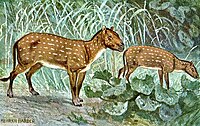User:Abyssal/Portal:Paleogene
IntroductionThe Paleogene Period (IPA: /ˈpeɪli.ədʒiːn, -li.oʊ-, ˈpæli-/ PAY-lee-ə-jeen, -lee-oh-, PAL-ee-; also spelled Palaeogene or Palæogene) is a geologic period and system that spans 43 million years from the end of the Cretaceous Period 66 Ma (million years ago) to the beginning of the Neogene Period 23.03 Ma. It is the first period of the Cenozoic Era, the tenth period of the Phanerozoic and is divided into the Paleocene, Eocene, and Oligocene epochs. The earlier term Tertiary Period was used to define the time now covered by the Paleogene Period and subsequent Neogene Period; despite no longer being recognized as a formal stratigraphic term, "Tertiary" still sometimes remains in informal use. Paleogene is often abbreviated "Pg", although the United States Geological Survey uses the abbreviation "Pe" for the Paleogene on the Survey's geologic maps. Much of the world's modern vertebrate diversity originated in a rapid surge of diversification in the early Paleogene, as survivors of the Cretaceous–Paleogene extinction event took advantage of empty ecological niches left behind by the extinction of the non-avian dinosaurs, pterosaurs, marine reptiles, and primitive fish groups. Mammals continued to diversify from relatively small, simple forms into a highly diverse group ranging from small-bodied forms to very large ones, radiating into multiple orders and colonizing the air and marine ecosystems by the Eocene. Birds, the only surviving group of dinosaurs, quickly diversified from the very few neognath and paleognath clades that survived the extinction event, also radiating into multiple orders, colonizing different ecosystems and achieving an extreme level of morphological diversity. Percomorph fish, the most diverse group of vertebrates today, first appeared near the end of the Cretaceous but saw a very rapid radiation into their modern order and family-level diversity during the Paleogene, achieving a diverse array of morphologies. (Full article...) Selected article on the Paleogene world and its legacies
A fungus (/ˈfʌŋɡəs/; plural: fungi) is a member of a large group of eukaryotic organisms that includes microorganisms such as yeasts and molds, as well as the more familiar mushrooms. These organisms are classified as a kingdom, Fungi, which is separate from plants and animals. One major difference is that fungal cells have cell walls that contain chitin, unlike the cell walls of plants and some protists, which contain cellulose. These and other differences show that the fungi form a single group of related organisms, named the Eumycota. The discipline of biology devoted to the study of fungi is known as mycology. Genetic studies have shown that fungi are more closely related to animals than to plants.
Abundant worldwide, most fungi are inconspicuous because of the small size of their structures, and their cryptic lifestyles in soil, on dead matter, and as symbionts of plants, animals, or other fungi. They may become noticeable when fruiting, either as mushrooms or molds. Fungi perform an essential role in the decomposition of organic matter and have fundamental roles in nutrient cycling and exchange. However, little is known of the true biodiversity of Kingdom Fungi, which has been estimated at 1.5 million to 5 million species. Phylogenetic studies published in the last decade have helped reshape the classification of Kingdom Fungi, which is divided into one subkingdom, seven phyla, and ten subphyla. A group of all the fungi present in a particular area or geographic region is known as mycobiota. (see more...) Did you know?
Need help?Do you have a question about Abyssal/Portal:Paleogene that you can't find the answer to? Consider asking it at the Wikipedia reference desk. Selected image
Selected article on the Paleogene in human science, culture and economics
The history of paleontology traces the history of the effort to study the fossil record left behind by ancient life forms. Although fossils had been studied by scholars since ancient times, the nature of fossils and their relationship to life in the past became better understood during the 17th and 18th centuries. At the end of the 18th century the work of Georges Cuvier ended a long running debate about the reality of extinction and led to the emergence of paleontology as a scientific discipline.
The first half of the 19th century saw paleontological activity become increasingly well organized. This contributed to a rapid increase in knowledge about the history of life on Earth, and progress towards definition of the geologic time scale. As knowledge of life's history continued to improve, it became increasingly obvious that there had been some kind of successive order to the development of life. After Charles Darwin published Origin of Species in 1859, much of the focus of paleontology shifted to understanding evolutionary paths. The last half of the 19th century saw a tremendous expansion in paleontological activity, especially in North America. The trend continued in the 20th century with additional regions of the Earth being opened to systematic fossil collection, as demonstrated by a series of important discoveries in China near the end of the 20th century. There was also a renewed interest in the Cambrian explosion that saw the development of the body plans of most animal phyla. (see more...) TopicsGeochronology - Paleogene (Paleocene - Eocene - Oligocene) Paleogene landmasses - Major Paleogene events - Paleogene biota appearances - Fossil sites - Stratigraphic units - History - History of paleontology - Timeline of paleontology Researchers - Culture - Treatise on Invertebrate Paleontology - Vertebrate Paleontology SubcategoriesQuality ContentThings you can doRelated contentAssociated WikimediaThe following Wikimedia Foundation sister projects provide more on this subject:
|





















